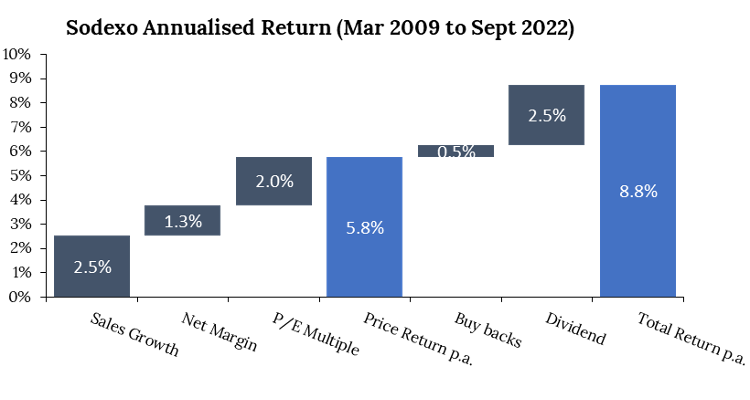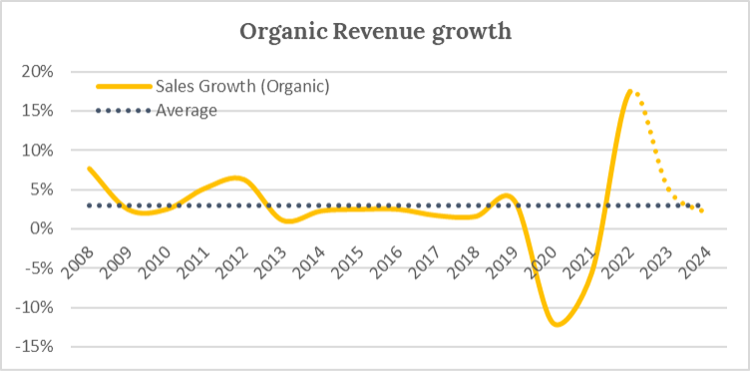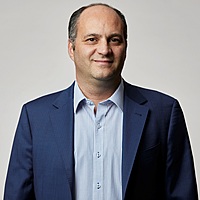The French facilities company that's catering to an uncertain future
In our September quarter’s Investment Insights section, we deconstructed the total return of the S&P500 Index into its fundamental building blocks and highlighted that significant risks to future returns lie ahead.
For our stock in focus we apply the same framework in our bottom-up work and aim to discover opportunities where the opposite is true. Sodexo neatly fits the bill.
Business Overview
French-based Sodexo is the world’s second largest catering and facilities management provider servicing a broad cross-section of industries. In addition to these on-site services, Sodexo also operates one of the most popular global voucher businesses, accounting for ~20% of pre-COVID earnings. Employers can use vouchers as incentives or gifts for their employees. On a group-wide basis, Sodexo employs 412,000 employees across 52 countries, generating annual revenues of more than €20bn.
Sodexo has delivered a solid 8.8% compound annual growth for over a decade
A total shareholder return of 8.8% per annum since the GFC is solid but not spectacular when compared to rates several points ahead of this for the S&P500 and other global indices. Dig deeper, however, and the quality of returns starts to stack up more favourably. Roughly a third of total shareholder returns came from income (dividends and share buy-backs) compared with just 15% for the S&P500. Another 30% came from sales growth while P/E expansion and margin improvement, volatile and mean-reverting components, contributed just over a third versus more than 60% for the S&P500.
History does not provide a reliable guide to the future, but it helps frame a starting point for our assessment of what is probable.

Source: Bloomberg, Talaria Estimates
Positive skew
Revenue growth
Sodexo operates in a growing industry with momentum underpinned by the ongoing outsourcing of catering and facilities management services. They have delivered a very steady organic growth rate that has averaged 3% per annum over the past 15 years. Other than the pandemic years, the company has never had a negative organic growth year. But with COVID largely behind us, as of Q3 FY22 revenues for Sodexo are now running at ~97% of FY19 levels.
In a more “normal” recession the business model offers defensive characteristics courtesy of its staple-like product offering and the fact that most customers are secured into long-term contracts (the company kept growth steady during the GFC). On this basis, our forecast revenue growth of ~3% pa over the coming years embedded within our valuation, seems realistic.

Source: Talaria estimates, company accounts
Margin
Global catering is a very low margin and high asset turnover business. Despite low single digit margins the industry consistently delivers 20%+ ROIC. Sodexo has delivered an average net margin of 3% since 2006. Management has guided in the latest results release that margin expansion will continue trending upwards supported by inflation-linked contracts that provide a benefit to the bottom line with a lagged effect. We expect margins to recover towards 3.8% in our base case. Our stress case assumes the margin reverts to the long-term average of 3%.
Valuation
Sodexo shares have traded consistently on a mid to high teens P/E ratio since 2005. The average is 18.6x and shares are currently trading on 17.5x. In our base case we assume no change to the P/E ratio, which we consider reasonable as it remains near the historic average. In a stress case we assume the company derates to 14x P/E, consistent with the GFC low.
Cash Flows and Capital Management
Excluding COVID years, Sodexo has had an excellent track record of generating Free Cash Flow (FCF). Additionally, Sodexo management have done well prioritising shareholder returns over the years. Consider that from 2010 to 2019, Sodexo generated cumulative FCF of €~6.5bn, of which more than 60% was returned to shareholders via buybacks and dividends. Also unlike other listed-catering peers, Sodexo did not go cup-in-hand to shareholders in the depths of COVID, managing to avoid what would have been a highly dilutive equity raise. Instead, management took the opportunity to restructure borrowings such that Sodexo now has a covenant-free balance sheet. Hence, Sodexo has already resumed paying dividends with the potential for more buybacks in coming years as leverage metrics continue improving.
A bridge to the future
Bringing it all together we present two scenarios for future returns over the next decade (see table).
Under our realistic case, dividend and buybacks will contribute to almost half of the ~8% expected compound annual growth rate (CAGR). Sales growth will contribute another third. Slight improvement in margins will round off the remaining quarter. We forecast no benefit from an improved valuation multiple.
In
a pessimistic scenario the shares do not meet our 8% target CAGR but still
deliver a positive return supported by Sodexo’s strong cash generation profile.
Income returned to shareholders of over 4% accounts for the entirety of
returns. Sales growth is more than offset by margin contraction towards the
long-term mean and valuation falling towards levels last seen during the depths
of the GFC.

Note that forecasts regarding future performance contained herein are based on our reasonable views and assumptions. They are not guaranteed to occur.
Put simply, Sodexo can continue delivering solid returns of ~8% to shareholders over the next decade in a consistent manner. Even under a stress scenario total return should remain positive – a gift in the current market environment.
5 topics

